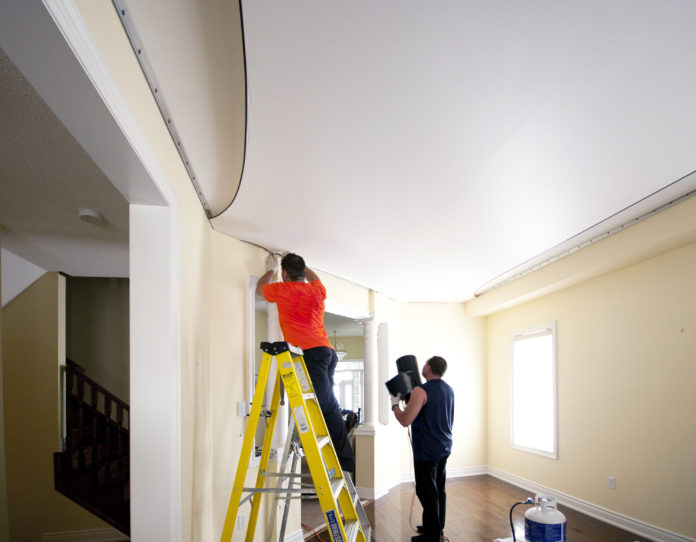What is Drywall Repair?
There are various reasons due to which drywall can get damaged, and numerous different solutions are there that can repair the drywall damaged. Generally, the drywall repairs can be categorized into two ways, one is minor damage drywall repair, and another is severe damage drywall repair. Both of these impact the treatment of drywall repair in the following ways:
- Minor drywall repair is associated with repairing minor issues like hairline cracks, cracked wall joints, or nails hole drywall repair services. These minor repair solutions relatively require few materials and are generally simple to carry on like joint tape and spackle. It took only one to two hours by the handyman and charged up to $60-$90 for an hour.
- The major and severe drywall repairs involve repairings like larger holes, failed seams, corners, and water damages and require more hard work to do when water damage solutions take place the larger sections of the drywall that are needed to get totally replaced and removed from the drywall.
Different Types of Drywall

There are basically two major types of drywall that you can easily find in your house. One is Lightweight sheetrock drywall that is easily available to you for around $8.98 for 8 feet of the sheet. These types of drywall sheets are lighter in weight that makes them ideal for use in the construction ceilings, however, one can also use them for making walls. Hence there will be less wastage of material because it is used for making both walls and ceilings.
There are several benefits of using lightweight sheetrock. This type of drywall has more flexibility, so it doesn’t get damaged easily and is less prone to breakages and also sheetrock repair is easy to do. As this sheet is not very heavy, there may be few chances of fatigue among the laborers and few probabilities of injuries during installation. In addition, the benefit if lightweight sheetrock includes:
- It Is easy to cut
- Has lesser dust
- Has higher strength and weight ratio than that of traditional drywall
- Also comes in various ranges of lengths like 8, 9, 10, 12 feet
In most of the houses, you probably may find the traditional and all-purpose drywall sheets. This type of drywall sheet are one of the common sheet materials that are used in the construction of the building, which has a cost of about $10.96 per 8-foot sheet. These types of drywall sheets have several benefits too, like:
- It looks better in Appearance: much more better than that of old lath or plaster
- It is an energy saver and efficient
- Resistant to fire
- Cost-effective
- Easy for repairs and remodeling
How To Get Repair for Cracks and Holes In Drywall

Drywall damages are ranging from small cracks to larger holes, but most of the drywall repairs are easy to do and even not expensive to fix. We have come up with the six different steps from which one can make repairs to the drywall according to the size, types, and spot of the drywall damage. You can learn how to patch the drywall hole and corner. If you are looking for ways on how to fix the drywall then checkout our below mentioned steps to repair the drywall.
Step 1
Drywall Sheet Repair – Surface Crack Repairs
Drywall seams to be paper-like covering on the ceiling and walls that rarely get splits or cracks like the plaster walls. Whenever the cracks appear on the walls, it is due to the joints between the two drywall sheets, which can easily be fixed.
If the cracks appeared on the horizontal or vertical seam, you could carefully try to widen the cracks with the corner of a paint scraper. You can also use a knife or chisel if the cracks get extended that is completely covering the seam and also if the tape gets loose and pulled out of the wall.
You can try to fill the cracks by using the new compound simply for drywall sheet repair. When you are applying that compound, you must hold the knife at the angle of 70 degrees and swipe it over the cracks.
You should make sure that the knife is clean by scratching or scraping both sides of the knife over the pan’s edge. Also, make sure that you should take care of the compound that it completely gets over and filled in the cracks completely and after that lightly sand the area. At last, wipe out the area from dust and paint over it.
Step 2
Drywall Sheets Deep and Wide Cracks Repair
In case the cracks get expands from the seams of the paper tape or if it gets pulled from walls, you must use a razor knife to cut that tape for about 6 to 12 inches from both the ends of the damaged drywall sheets. You can remove the tape now but you should be careful that you do not tear off the entire drywall paper covering. If you see any extra filling compound on the surface, then you must clean it off with the help of the tool like razor knife or use drywall saw in case you want to expand the cracks through the surface of the walls to reach the stud cavity. Also, keep care of that you do not remove the solid, it should be a well-adhered compound beyond the surface of the cracks.
You can use a new drywall compound to fill the expanded cracks and apply the thin layer of coating on the wall surface from where you remove the tape. If the compound is still wet, you can place the fiberglass tape strip over the seam, which is bringing the gap among the ends of the drywall sheets of the extending tape. You can also use a putty knife to smoothly and gently flatten and remove the wrinkles from the tape and to bed compound with the tape smoothly.
Step 3
Drywall Sheets Nail Pop Repair
Another one of the most common problems faced with the drywall, especially in the new homes, is “nail pops” or nails that are pulled away from protrude and wood studs through the drywall sheet, paint, or tape. Nail pops are usually caused by the warped wood, which is almost inadequately dry during the time of installation. Even though there are fewer chances of drywall falling off the wall, but the bumps on the surface are clearly visible.
What you can do to fix this drywall issue is that you can scrap the drywall using a utility knife till the screw bumps do not get removed from the sheet.
To remove these nail pops, we have searched two ways to remove these nails pops like first is, use hammer or screwdriver to push the nail back to the studs, and then closely spaced the drywall screws by bracket each head of the nail. Or, the second method is that you can remove the nail and drive another screw in its place, along with the second screw nearby the first one so that you can re-secure the drywall sheet to the stud.
Step 4
Drywall Corner Bead Repair
The outer corners of the drywall are strengthened with the plastic edging or metal that is called as Corner bead. Even though these beads are the damage resistant, but the sharp knock tools can cause the compound of the drywall cracked and chip off, or any strong shock or force on the drywall can cause the damage to the drywall surface or create a dent and bend to the corner beads. Such types of damages are confined between the short section that can easily be replaced and cut away from the drywall.
If you find that the damages are only limited to the compound of the drywall, then you can simply remove all of the loose material and then apply the new layer of compound to it. In such cases, you are not required to tape over the new compound.
Step 5
Drywall Hole Repair
Seeking for how to fix holes in the wall?There are a variety of drywall patch holes repair kits are available for about six inches holes. These kits have a reinforced center panel that is surrounded by self-sticking tape. You can adhere the patch to the wall and cover them with the compound of the drywall.
If you want, you can also repair the large holes of drywall by creating your own patch compound. Those holes that do not get extended to the other side of the stud, you only need to reinforce those holes. To repair such holes, you only need to measure the holes then cut the scrap piece of the same drywall, which is slightly larger than the diameter of the hole. Then you need to place that drywall circled piece over the damaged area and trace that area with the pencil. After that use, drywall saw to cut that area within the traced lines. Cut the two drywall pieces for about 2×4 pieces that are slightly larger than the corner hole. Now vertically positioned the cut pieces into the holes on each side of the hole. Secure drywall with the screws and then set the new drywall to the hole and again secure it with the screws.

















